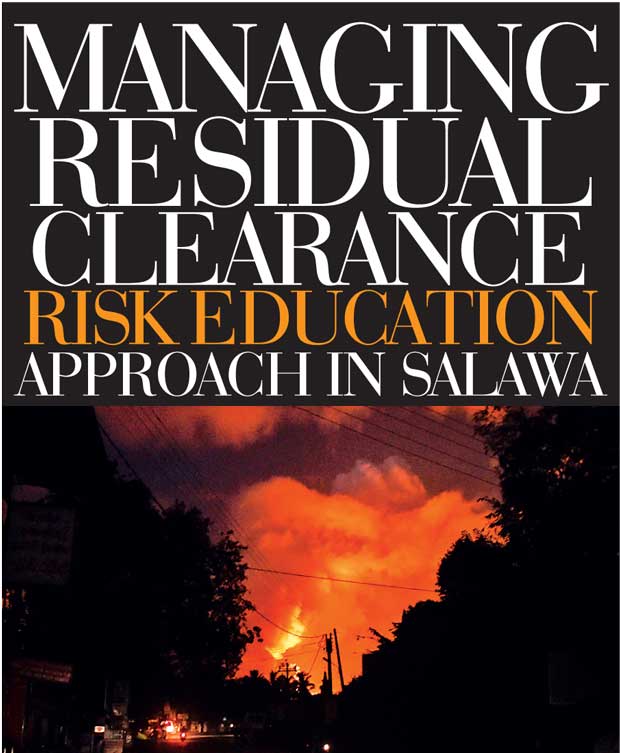Reply To:
Name - Reply Comment

 he fire at the armoury of the Army Camp in Salawa on June 5 had scattered weapon and ammunition fragments and shrapnel over a wide area resulting in thousands of people displaced and housed in nine temporary shelters in Colombo and Gampaha. Residents living within the 500 metre-radius of the army camp have not been permitted to return to their homes because of unexpected explosions. Factors contributing to this threat include increasingly unstable environments, due to the inadequate information on the scale and impact of Unexploded Ordnance (UXO) contamination. The current threat in this area is difficult to quantify due to the lack of coherent data concerning exact locations and contextual information on UXO-related data. One of the immediate challenges facing Salawa is the removal of the explosives and the prevention of casualties from UXO contamination. After addressing immediate concerns, including protecting citizens and critical national infrastructure from explosive hazards, the Government is striving to secure safe environments for daily life.
he fire at the armoury of the Army Camp in Salawa on June 5 had scattered weapon and ammunition fragments and shrapnel over a wide area resulting in thousands of people displaced and housed in nine temporary shelters in Colombo and Gampaha. Residents living within the 500 metre-radius of the army camp have not been permitted to return to their homes because of unexpected explosions. Factors contributing to this threat include increasingly unstable environments, due to the inadequate information on the scale and impact of Unexploded Ordnance (UXO) contamination. The current threat in this area is difficult to quantify due to the lack of coherent data concerning exact locations and contextual information on UXO-related data. One of the immediate challenges facing Salawa is the removal of the explosives and the prevention of casualties from UXO contamination. After addressing immediate concerns, including protecting citizens and critical national infrastructure from explosive hazards, the Government is striving to secure safe environments for daily life.
UXO include artillery and tank shells, mortars, fuses, grenades, large and small bombs including sub-munitions, rockets and missiles. UXOs are often extremely unstable and can detonate at the slightest touch. Accidental injuries often occur when people are farming or undertaking construction work in contaminated areas and intentionally touch, move or tamper with them. Some UXOs also contain motion-sensitive fuses or magnetic sensors; other UXOs may have a timed self-destruction feature that may not have functioned properly. Because the state or condition of UXOs cannot easily be determined they must all be considered extremely dangerous and should never be touched or disturbed by anyone except by Explosive Ordnance Disposal (EOD) professionals.
The responsible authorities, perhaps with international support, should logically adopt a proactive approach to defuse UXOs and clear them without unnecessary delay. Implementation may involve a rapid survey covering the areas with clearance operations aiming for exhaustive eradication of UXO, as priority. With time and progress, these operations will report a decline in UXO encounters and prioritize safety assurances of contaminated areas from surface and shallow explosives. Meanwhile, hazards associated with remaining UXOs can be mitigated through risk education, responsive local threat assessments and EOD. 
Sri Lanka has extensive experience in conducting Risk Education to minimise deaths and injuries from landmines and Explosive Remnants of War (ERW) among high-risk communities in the Northern Province, as an integral component of its long-term humanitarian de-mining mission since the end of the conflict in 2009. The Mine Risk Education (MRE) support was expanded by UNICEF, in partnership with the National Mine Action Centre, Sri Lankan Ministry of Education and other local and UN organisations, to the hundreds thousands of people returning home to former war zones where ERW and landmines still contaminate the areas. MRE is defined as “activities which seek to reduce the risk of injury from mines/ERW by raising awareness of men, women and children in accordance with their different vulnerabilities, roles and needs and promoting behavioural change.” Today, a variety of MRE activities take place every day in many different mine/explosive-remnants-of-war-affected countries reaching large numbers of beneficiaries.
UXO accidents are more lethal than landmines due to their higher explosive and fragmentation content. The fire, which broke out at the armoury of the Salawa Army Camp, left a trail of destruction by the time it was contained. Army engineers are currently engaged in operations within the camp to gather shrapnel and defuse unexploded ordnance. However, a protection gap exists in situations where UXOs constitute a serious risk for civilians. The ‘protection’ umbrella ensures people’s safety and security and focuses on preserving their dignity. This perspective explicitly recognizes the paramount need for integrating an emergency UXO Risk Education programme to inform people in Kosgama about the dangers of UXO when travelling through areas around the camp or upon return to their homes. This is because they are unfamiliar with the exact nature and extent of the threat they will face. The objective of Risk Education should be to provide sufficient information to residents and travellers, particularly children in Kosgama to recognize and report UXOs to the appropriate authorities. The authorities can then remove the items, making the area safe for people and creating an environment where economic and social development can occur free from the constraints imposed by contamination. However, children and adults can practice safe behaviour if educated about UXO risks and how to react when encountering UXOs at home, in the garden or school yard or by the roadside.
In an emergency modality, risk education can be made as direct presentations to large groups of people, posters, leaflets, billboards, brochures, broadcasting risk education messages at different times on different days and through different radio and TV channels. It is primarily a one-way form of communication transmitted through mass media. In addition, recent technological developments enable communication over the internet. An international de-mining agency launched a mobile app in 2014, allows users to obtain comprehensive information about UXOs and suspected areas in the Philippines by selecting a desired location.
Although media coverage helps prevent UXO incidents, until all the areas are cleared, the most important form of prevention from UXO incidents is the warning-sign. Dr. U. Anura Kumara, Dean of the Faculty of Management Studies & Commerce of the University of Sri Jayewardenepura suggests that the media should stop broadcasting visuals of professionals (military) handling UXOs, because ordinary people might “take it easy” and try unsafe methods and subsequently suffer fatal accidents. The media’s social responsibility should be based on joint liability of all social subjects, because its interactive relationship with public requires ethical behaviour in the protection of civil interests and needs.
Risk Education can also be provided to children of school-going age through extra-curricular activities that include outdoor activities such as role playing, leaflet distribution, puzzles, games safe-behaviour guidance and take the messages and supporting materials home to share with family members, friends and neighbours and teach how to protect themselves from UXO incidents.In the meantime, Kosgama residents can be safe if they understand how to protect themselves and their families from injury and death, and report munitions for safe removal and destruction.
The Writer is a Mine Risk Education (MRE) Project Manager with the Swiss Foundation for Mine Action (FSD) with extensive experience working in Sri Lanka, Switzerland, Myanmar Philippines and Ukraine. Currently, she is reading for her Doctor of Philosophy in Management under supervision of Professor Dammika. A. Tantrigoda and Dr. U. Anura Kumara in the University of Sri Jayewardenepura.